Military MRE
In 1963, the Department of Defense began developing the “Meal, Ready to Eat”, a ration that would rely on modern food preparation and packaging technology to create a lighter replacement for the C ration.
In 1966 they produced Long Range Patrol or LRP rations, a dehydrated meal stored in a waterproof canvas pouch. In 1975, work began on a dehydrated meal stored in a plastic retort pouch. It went into special issue starting in 1981 and standard issue in 1986, using a limited menu of 12 entrees
Each current MRE provides an average of 1,250 calories (13% protein, 36% fat, and 51% carbohydrates) and 1/3 of the Military Recommended Daily Allowance of vitamins and minerals. A full day’s worth of meals would consist of three MRE. A MRE normally contained the following items.
- Entree – the main course, such as Spaghetti or Beef Stew
- Side dish – rice, corn, fruit, or mashed potatoes, etc.
- Cracker or Bread
- Spread – peanut butter, jelly, or cheese spread
- Dessert – cookies or pound cakes
- Candy – M&Ms, Skittles, or Tootsie Rolls
- Beverages – Gatorade-like drink mixes, cocoa, dairy shakes, coffee, tea
- Hot sauce or seasoning – in some MREs
- Flameless Ration Heater – to heat up the entree
- Accessories – spoon, matches, creamer, sugar, salt, chewing gum, toilet paper, etc.
Shorter shelf life
I have recently received information on a new shelf life chart being used by Ameriqual one of the three current manufacturers used by the military. This chart shows a shorter shelf life than the previous chart. The old chart is widely published on the internet. This chart was developed in the 1980s when the MREs first came out and projects up to 130 months of storage at 60 °F. These first MREs contained a number of freeze dried components. Today’s MREs no longer contain the freeze dried components and there have been other changes to improve the taste. This accounts for the shorter shelf life. The top chart is the new one that indicates the shelf life of AmeriQual’s C-MRE, APack Ready Meals. Information is based on NATICK’s study and evaluation of the military’s Meals Ready to Eat (MRE), which employs identical packaging and production technologies as our C-MRE, APack Ready Meals. The bottom chart is the old one that came out in the 1980s.

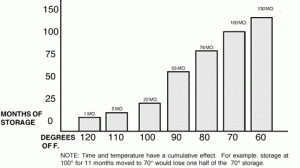 Defense logistics agency How long will it last?
Defense logistics agency How long will it last?
“The shelf life of the MRE is three (3) years at 80 degrees F. However, the shelf life can be extended through the use of cold storage facilities prior to distribution.” The previous statement is taken directly from the current website of the defense Logistics agency and confirms the information given on the new chart.
But do not despair, if you have a stack of the older MREs, I have eaten old ones that were over 15 years old. The taste was not quite as good, but they did not kill me. They had been stored under good conditions.
My own feeling is that the majority of the MRE components will probably last considerably longer. But some MRE components might not fare so well over time. Here are two examples of tests with pictures taken from the defense Logistics agency website. Cheese spread and the applesauce. Note the color changes in the samples correspond with new shelf life chart.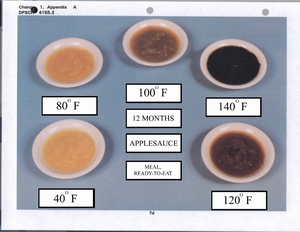
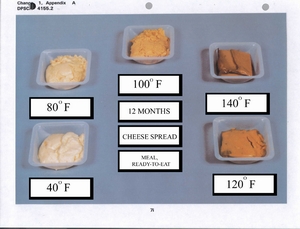
More About MRE Shelf Life
1. The shelf life ratings shown in the chart on the front of this paper were determined by taste panels -panels of “average” people, mostly office personnel – at the Natick lab. Their opinions were combined to determine when a particular component, or in this case the entire MRE ration, was no longer acceptable.
2. The shelf life determinations were made solely on the basis of taste, as it was discovered that acceptable nutritional content and basic product safety would extend way beyond the point where taste degradation would occur. This means the MREs would be safe and give a high degree of food value long after the timing suggested in the chart.
3. MRE pouches have been tested and redesigned where necessary according to standards much stricter than for commercial food. They must be able to stand up to abuse tests such as obstacle course traversal in field clothing pockets; storage outdoors anywhere in the world; shipping under extremely rough circumstances (such as by truck over rocky terrain); 100% survival of parachute drops; 75% survival from free failure drops; severe repetitive vibration (1 hour at G vibration); 7,920 individual pouch drops from 20 inches; and individual pouches being subject to a static load of 200 pounds for three minutes.
4. Freezing an MRE retort pouch does not destroy the food inside, but repeated freezing increases the chance that the stretching and stressing of the pouch will cause a break on a layer of the laminated pouch. These pouches are made to withstand 1,000 flexes, but repetitive freezing does increase the failure rate by a small fraction of a percent. Also if MRE food is frozen, then thawed out, it must be used the same as if you had thawed commercial food from your own freezer at home
Time and temperature indicator
Since about 1997, MRE cases have also included something called a TTI (time and temperature indicator) on the outside of the box to assist inspectors in determining if MREs are still good. There are two parts to the TTI – an outer dark circle and an inner light circle. As long as the inner circle is still lighter than the outside circle, the MREs are supposed to be good. The following picture show an example of a TTI.
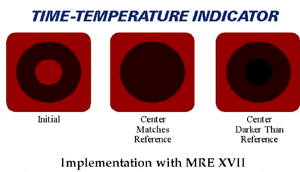
Buying MRE’s
About 1997 the government started posting the following notice on all MRE boxes:. ![]() While this notice seems to have cut down on some of the larger sales you can still find perfectly good MREs pretty easily at some surplus stores and on various internet auction sites.
While this notice seems to have cut down on some of the larger sales you can still find perfectly good MREs pretty easily at some surplus stores and on various internet auction sites.
Tomorrow I will discuss Civilian MREs there good points and down falls.

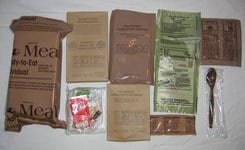
How do I know when the packet was produced and the shelf life time clock started ? It is a packet of ‘Market Street’ chunk chicken in a plain silver packet. Please enlighten me.
Thanx,
Dave